A decade in the business and it looks like Zero Motorcycles is on a roll. After a year spent dramatically updating the running gear—switching to Showa suspension, J-Juan brakes, and Pirelli tires—and getting Bosch ABS for the first time, Zero has continued to drive its product line forward. For 2016, there are two new models, technical updates across the line, and even a new motor. All Zero models feature internal 120-volt chargers and ABS.
Motor Madness
For 2016, Zero has improved upon its air-cooled, brushless motor. According to the company, the Interior Permanent Magnet motor provides torque more efficiently and sheds heat better than before. This is important because in our testing extended high-speed travel on the non-R models could quickly find the motors' temperature limits. When that happens, controllers begin to reduce max-available torque to keep temps in check, often resulting in limited top speeds and slower acceleration. All Zero models drive through a fiber-reinforced belt and come with internal chargers.
Charge Tank
Zero has also expanded the ways some of its models can be recharged. In all by the FX-series bikes, there's a cavity above the main battery array that can be used as a storage compartment or filled with an additional battery module for increased range. New this year is the Charge Tank, which takes that physical space (meaning you can't have a Charge Tank and a Power Tank on the same bike). The Charge Tank allows use of the popular J1772 charging plug found at many Level 2 electric-car charging stations. (J1772 is an SAE standard.) Previously, the Zeros depended on internal 120-volt chargers and/or a series of external charging packs; the more packs, the faster the batteries recharged. Zero says that bikes fitted with the ZF9.8 (9.8 kWh packs) charge to 95 percent in two hours, and the ZF13.0 packs charge to the same rate in about three hours using the Charge Tank and a J1772 external charging system. That same ZF13.0 pack, fed from a single 120-volt household source, will take 10.3 hours to charge to 95 percent. Even better, the Charge Tank can be retrofitted to all non-FX 2015 models.
Battery Upgrades
As Zero's Chief Technology Officer told us last year, there's more to battery technology than simple stated capacities. It's possible to refine each cell's chemistry to optimize capacity over raw current flow—and, yes, this is an oversimplification—to create the ideal balance between raw performance and capacity, which is the prime influencer of range. This year, Zero's packs have edged up slightly in capacity. For 2015, the top packs in the Zero S, for example, were the ZF9.4 and ZF12.5, signifying total capacities of 9.4 kWh and 12.5 kWh, respectively. This year, the packs are 9.8 and 13.0 kWh capacities. Adding a Power Tank to any of the applicable models (everything but the FX) results in 15.9 kWh total capacity. You could power a small city with that!
About the range figures listed below. Zero offers a host of range figures for each model. We’ve chosen to highlight just three of the five: city, highway combined (at 55 mph), and highway combined (at 70 mph). City is just that, urban travel, stop-and-go, no sustained high speed. The combined figures assume a half-and-half use of city and highway at the stated average speed. (Zero does not list a range for our Southern California test loop, which amounts to “hit the freeway and pin it.”)
New for '16: The Zero FXS
Light and frisky, the Zero motocross-style FX was always the closet hooligan of the lineup. And now it has a more street-biased brother in the FXS, which is your basic supermoto electric bike. A what? Don't worry, it'll make sense soon enough. Instead of the 21/18-inch wheel combo the FX uses, the FXS rides on street-ready 17-inchers.
We liked the FX we rode during the launch of the Zero 2015 lineup, and the supermoto should be just as fun. Both FX models use the Z-Force 75-5 motor and 420-amp controller, giving 44 hp and 70 pound-feet of torque. As before, the FX chassis carries one or two battery models, resulting in max capacities of 3.3 kWh or 6.5 kWh.
Range for the FX on the larger pack is 82 miles city, 62 miles combined city/highway (at 55 mph), and 49 miles combined (at 70 mph). Top speed is 85 mph. The FXS has slightly better range with any given battery pack—90/68/52 miles, respectively. Curb weights range from 247 to 293 pounds.
The FX and FXS are the same price: $8,495 with the ZF3.3 battery pack and $10,990 with the ZF6.5 pack.
The Zero DS and DSR
Last year's dual-sport DS returns with the across-the-board lineups and brings with it a new performance version. As Zero did with the S roadster, fitting a more powerful motor brings instant visceral improvements, including stronger acceleration and snappier response. That's the new DSR, which uses the stouter motor from the Zero SR. It produces 67 hp and 106 pound-feet of torque—the base motor is good for 54 hp and 68 pound-feet. The R model also gets a higher-capacity controller (660 amps instead of 420). Speed is the word here, with the DSR going 0-60 mph in 3.9 seconds, according to Zero, versus 5.7 seconds on the DS.
Both the DS and DSR can be ordered in 9.8 or 13.0 kWh capacities and can be fitted with the Power Tank or the Charge Tank. Range is variable by performance and capacity, as always. The standard DS ZF9.8 has a city range of 110 miles, highway combined (at 55 mph) of 83 miles, and a highway combined (at 70 mph) of 71 miles. Those numbers go to 147/110/95 with the ZF13.0 pack, and to 179/134/116 with the ZF13.0 and a Power Tank.
The DSR is only available with the larger main battery pack, the ZF13.0, and listed ranges are the same as for the less-powerful DS model. Curb weights range from 381 to 463 pounds.
Prices start at $10,995 for the Zero DS ZF9.8 (a reduction of $1,000 from last year despite the greater battery capacity); a DS ZF13.0 runs $13,995 (same as last year), while the DSR ZF13.0 costs $15,995. Add a Power Tank to any of them for $2,674 or a Charge Tank quick-charger for $1,988.
The Zero S and SR
For 2016, both of Zero's performance/roadster models make a return. Powertrains are essentially the same as on the DS models, with a 54-hp base motor and an up-spec 67-hp R version. Because the S and SR models are slightly more aerodynamically efficient they have better range to go with their surprisingly good performance—Zero claims a 0-60 time of 3.3 seconds for the lightest SR example.
Range improves for the S and SR based on increased battery capacities. From the Zero S ZF9.8 range is 121 miles city, 91 miles highway combined (at 55 mph), and 81 miles highway combined (at 70 mph). With the larger ZF13.0 pack, range extends to 161/122/108 miles respectively. Adding a Power Tank increases range to 197/149/131 miles. Curb weights range from 399 to 458 pounds.
Prices start at $10,995 for the Zero S ZF9.8 (a reduction of $1,000 from last year despite the greater battery capacity); a S ZF13.0 runs $13,995 (same as last year), while the SR ZF13.0 costs $15,995. Add a Power Tank to any of them for $2,674 or a Charge Tank quick-charger for $1,988.
A complete list of accessories is also available for the Zero lineup.










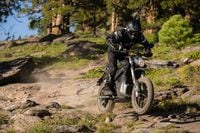
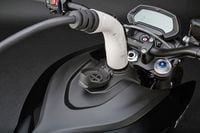

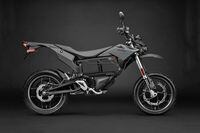
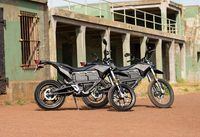



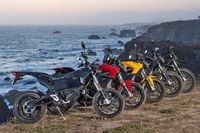
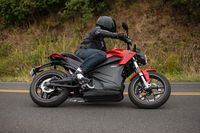
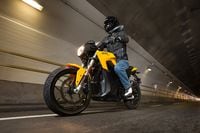
/cloudfront-us-east-1.images.arcpublishing.com/octane/7GJYDUIPXRGMTMQKN6ONYOLBOU.jpg)
/cloudfront-us-east-1.images.arcpublishing.com/octane/MUQLOVLL2ZDGFH25ILABNBXKTI.jpg)
/cloudfront-us-east-1.images.arcpublishing.com/octane/TNOU5DNE2BC57MFPMGN2EIDXAM.jpg)
/cloudfront-us-east-1.images.arcpublishing.com/octane/GTCXACQGJ5HAPDTGWUQKDEH44E.jpg)
/cloudfront-us-east-1.images.arcpublishing.com/octane/S35YGSEMEZB4BLTDJTSZPF4GLA.jpg)
/cloudfront-us-east-1.images.arcpublishing.com/octane/5UOT6HPX2JFMRJAX6EH45AR4MQ.jpg)
/cloudfront-us-east-1.images.arcpublishing.com/octane/OKWOJWAKP5EP3OACCRRWPCIX2Q.jpg)
/cloudfront-us-east-1.images.arcpublishing.com/octane/2WF3SCE3NFBQXLDNJM7KMXA45E.jpg)
/cloudfront-us-east-1.images.arcpublishing.com/octane/G4MG6OUCJNBSHIS2MVVOTPX65E.jpg)
/cloudfront-us-east-1.images.arcpublishing.com/octane/IIGGWFOTOJGB7DB6DGBXCCMTDY.jpg)
/cloudfront-us-east-1.images.arcpublishing.com/octane/QSTCM6AVEZA5JJBUXNIQ3DSOF4.jpg)
/cloudfront-us-east-1.images.arcpublishing.com/octane/U4I7G625B5DMLF2DVIJDFZVV6M.jpg)
/cloudfront-us-east-1.images.arcpublishing.com/octane/B6XD6LS6IVCQPIU6HXDJSM3FHY.jpg)
/cloudfront-us-east-1.images.arcpublishing.com/octane/ICL63FEDDRDTTMINYICCEYGMDA.jpg)
/cloudfront-us-east-1.images.arcpublishing.com/octane/FCGZHQXRBZFLBAPC5SDIQLVF4I.jpg)
/cloudfront-us-east-1.images.arcpublishing.com/octane/WNOB6LDOIFFHJKPSVIWDYUGOPM.jpg)

/cloudfront-us-east-1.images.arcpublishing.com/octane/X33NU3E525ECRHXLNUJN2FTRKI.jpg)
/cloudfront-us-east-1.images.arcpublishing.com/octane/6KKT5NNL2JAVBOXMZYS5ZO76YA.jpg)
/cloudfront-us-east-1.images.arcpublishing.com/octane/J5RKG5O455GMPGQRF2OG6LRT7A.jpg)
/cloudfront-us-east-1.images.arcpublishing.com/octane/GX2CIZKQVRH2TATDM26KFG2DAE.jpg)
/cloudfront-us-east-1.images.arcpublishing.com/octane/ZWIDYSAKQZHD5BHREMQILXJCGM.jpg)
/cloudfront-us-east-1.images.arcpublishing.com/octane/CYUHJZCTSJCH3MRAQEIKXK7SCQ.jpg)
/cloudfront-us-east-1.images.arcpublishing.com/octane/LKOFINY56FCXJCANJ5M7ZDQUBY.jpg)